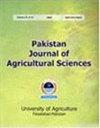Training needs of Pakistani farmers regarding recommended production technology of rice
IF 0.6
4区 农林科学
Q3 AGRICULTURE, MULTIDISCIPLINARY
引用次数: 0
Abstract
The training needs of rice growers in Punjab, Pakistan were assessed regarding the production technology used in growing rice. Total 332 rice growers were selected through random sampling technique from tehsil Nowshera Virkan, district Gujranwala and interviewed accordingly through a face to face interview technique. Data was analyzed using Statistical Package for Social Sciences (SPSS). Frequency, percentages, weighted mean and chi-square techniques were run on the data. Production technology was divided into two sections (i) major aspects and (ii) sub-aspects. Major aspects were 8 in number and 46 in sub-aspects. Findings indicated that almost 60 and 14.2% of the respondents had a low and medium level of training need. 21.5% of respondents had a high level of training needs. The average score of 128.28 indicated the medium level of training needs for the sampled farmers. Among major aspects, weed management and seed and seedlings embarked high level of training need. Whereas, in sub-aspects, 30 aspects show a low level of training, 12 in medium and 04 at a high level. Chisquare confirmed that socio-economic attributes and training need was no different. However, lower educational level in the area as 47.9% of respondents had no education asks for the due attention from the department of extension to formulate training programs for the farmers materializing the need and socio-economic position of the farmers.巴基斯坦农民对推荐的水稻生产技术的培训需求
评估了巴基斯坦旁遮普省水稻种植者在种植水稻所使用的生产技术方面的培训需求。通过随机抽样技术从古吉兰瓦拉区tehsil Nowshera Virkan选取332名水稻种植者,并通过面对面访谈技术对其进行访谈。数据分析采用SPSS (Statistical Package for Social Sciences)软件。使用频率、百分比、加权平均值和卡方技术对数据进行分析。生产技术分为两个部分(1)主要方面和(2)次要方面。主要相位有8个,子相位有46个。调查结果显示,近60%和14.2%的受访者有中低水平的培训需求。21.5%的受访者有高水平的培训需求。平均得分为128.28分,表明被调查农民的培训需求处于中等水平。在主要方面中,杂草管理和种苗需要开展高水平的培训。从子方面来看,低水平的有30个,中等水平的有12个,高水平的有04个。Chisquare证实,社会经济属性和培训需求没有什么不同。然而,该地区受教育程度较低(47.9%的受访者没有受过教育),要求推广部门给予应有的重视,制定针对农民的培训计划,以体现农民的需求和社会经济地位。
本文章由计算机程序翻译,如有差异,请以英文原文为准。
求助全文
约1分钟内获得全文
求助全文
来源期刊

Pakistan Journal of Agricultural Sciences
AGRICULTURE, MULTIDISCIPLINARY-
CiteScore
1.80
自引率
25.00%
发文量
18
审稿时长
6-12 weeks
期刊介绍:
Pakistan Journal of Agricultural Sciences is published in English four times a year. The journal publishes original articles on all aspects of agriculture and allied fields.
 求助内容:
求助内容: 应助结果提醒方式:
应助结果提醒方式:


